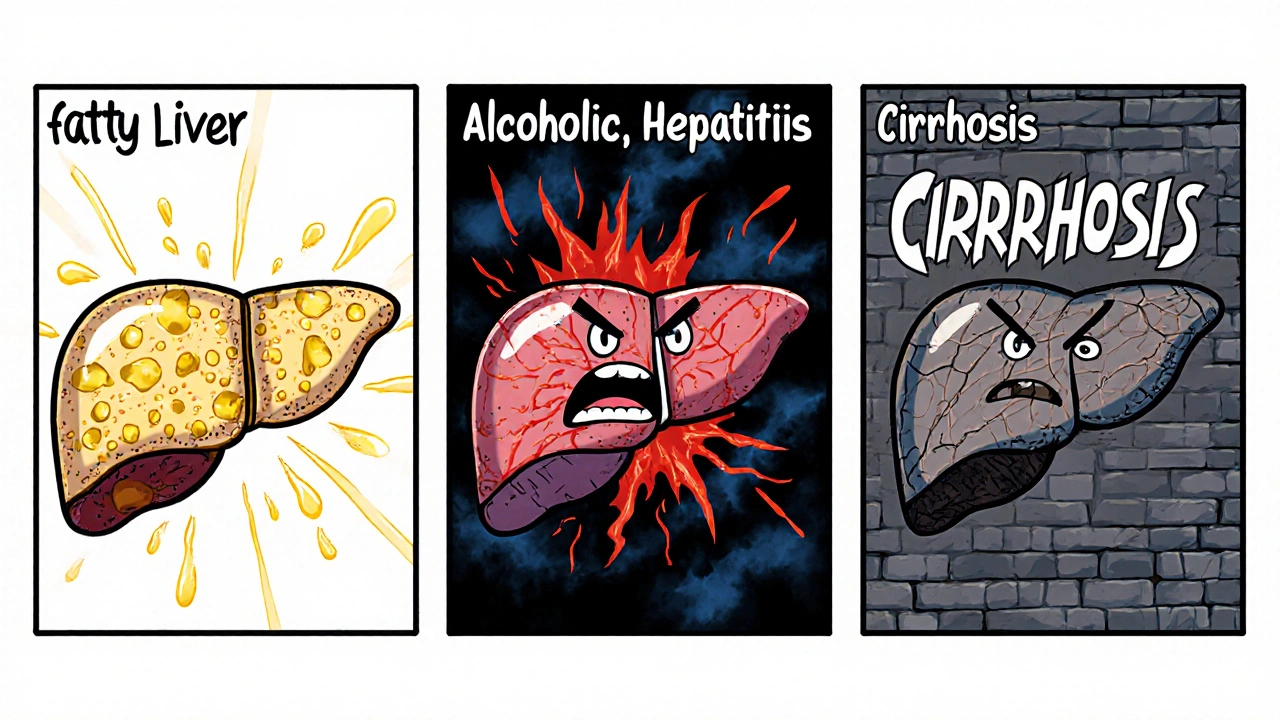Alcohol Units Calculator
This tool helps you calculate how many alcohol units you consume based on standard drink sizes. According to the article, drinking more than 14 units/week for women or 21 units/week for men significantly increases liver damage risk.
Calculate your alcohol consumption to understand your liver health risk.
Remember: 1 unit = 10ml of pure alcohol
When you hear the phrase “alcoholic liver disease,” you probably picture a heavy drinker with a yellowish tint to the skin. What you might not realize is how quickly regular drinking can move from a harmless buzz to irreversible liver failure. This guide breaks down the chemistry, the warning signs, and the steps you can take before the damage becomes permanent.
Key Takeaways
- Alcohol is metabolized into toxic chemicals that damage liver cells.
- The disease progresses through three stages: fatty liver, alcoholic hepatitis, then cirrhosis.
- Symptoms of advanced liver failure include jaundice, confusion, and fluid buildup.
- Early detection via blood tests (ALT, AST) and imaging can halt or even reverse damage.
- Complete abstinence, nutrition, and medical therapy are the most effective interventions.
How Alcohol Hurts the Liver
Alcoholic Liver Disease is a spectrum of liver injuries caused by chronic ethanol consumption. When you drink, the liver uses two main enzymes-alcohol dehydrogenase (ADH) and cytochromeP4502E1-to break ethanol down into acetaldehyde, a highly reactive compound. Acetaldehyde forms adducts with proteins, DNA, and lipids, triggering inflammation and oxidative stress.
These toxic by‑products overwhelm the liver’s natural antioxidant defenses, leading to cell death (apoptosis) and scar tissue formation (fibrosis). Over time, scar tissue replaces healthy liver parenchyma, disrupting blood flow and impairing essential functions like detoxification, protein synthesis, and clotting factor production.
Stages of Alcohol‑Related Liver Damage
The progression is not inevitable for every drinker, but the risk climbs sharply once weekly intake exceeds 14units for women or 21units for men (≈140g ethanol). Below is a quick snapshot of the three classic stages.
| Stage | Typical Findings | Reversibility |
|---|---|---|
| Fatty Liver (Steatosis) | Excess fat droplets in hepatocytes; normal liver enzymes or mild elevation | Usually reversible within weeks of abstinence |
| Alcoholic Hepatitis | Elevated ALT/AST (AST>ALT), fever, jaundice, tender enlarged liver | Partial recovery possible; severe cases may progress despite abstinence |
| Cirrhosis | Extensive fibrosis, portal hypertension, ascites, varices, markedly high AST/ALT | Rarely reversible; treatment focuses on slowing further damage |
Once cirrhosis sets in, the liver’s architecture is permanently altered. However, the disease can remain “compensated,” meaning the organ still performs many functions. Decompensation-when the liver can no longer keep up-ushers in true Liver Failure, a life‑threatening state.

Warning Signs of Advanced Liver Failure
Because early stages often feel “normal,” many people discover the problem only when complications appear:
- Jaundice: Yellowing of the skin and eyes as bilirubin builds up.
- Ascites: Fluid accumulation in the abdomen causing swelling and discomfort.
- Encephalopathy: Confusion, forgetfulness, or even coma due to toxins crossing the blood‑brain barrier.
- Variceal Bleeding: Enlarged veins in the esophagus or stomach that can rupture.
- Easy Bruising: Reduced production of clotting factors leads to prolonged bleeding.
These symptoms signal that the liver is no longer able to detoxify blood, synthesize proteins, or regulate fluid balance. Prompt medical attention is essential.
How Doctors Diagnose Alcohol‑Induced Liver Damage
Diagnosis blends history, lab work, and imaging. Here are the key components:
- Alcohol Use Assessment: Detailed questionnaire quantifying weekly units, binge patterns, and duration of drinking.
- Blood Tests: Liver enzymes (ALT, AST, GGT), bilirubin, albumin, platelet count, and coagulation profile (INR).
Typical pattern: AST is often twice the ALT in alcoholic injury. - Imaging: Ultrasound first, followed by CT or MRI if needed. These reveal fatty infiltration, nodular surface, and signs of portal hypertension.
- Liver Biopsy (rarely needed): Direct microscopic view confirms inflammation, fat, and fibrosis stages.
- Scoring Systems: MELD (Model for End‑Stage Liver Disease) predicts transplant priority based on bilirubin, INR, and creatinine.
Collectively, the data let clinicians differentiate alcoholic liver disease from viral hepatitis, non‑alcoholic fatty liver disease, or drug‑induced injury.
Managing the Disease: What Works and What Doesn’t
The cornerstone of treatment is complete abstinence. Even a single drink can restart the injury cascade once scar tissue is present. Below are evidence‑based strategies:
- Behavioral Therapy: Cognitive‑behavioral programs, motivational interviewing, and support groups (e.g., AA) significantly improve sobriety rates.
- Pharmacologic Aids: Naltrexone, acamprosate, and disulfiram help reduce cravings; they must be prescribed after liver function stabilizes.
- Nutritional Support: High‑protein, low‑sodium diet counters muscle wasting and fluid retention. Supplementation with thiamine, folate, and vitaminD is common.
- Medical Treatments for Hepatitis: Corticosteroids are sometimes used for severe alcoholic hepatitis, though benefits are modest.
- Management of Complications: Diuretics for ascites, beta‑blockers for variceal bleeding risk, and lactulose for encephalopathy.
- Liver Transplant: Considered when MELD score exceeds 15 and the patient maintains sobriety for at least six months (policy varies by center).
What doesn’t work? “Detox” kits sold over the counter, herbal “liver cleanses,” and high‑dose antioxidants have no proven benefit and can distract from real treatment.

When to Seek Help Immediately
If you notice any of the following, call emergency services or go to the nearest hospital:
- Sudden, severe abdominal pain with swelling.
- Vomiting blood or black, tar‑like stools.
- Rapid confusion, sleepiness, or inability to stay awake.
- Yellowing of skin that spreads quickly.
- Unexplained bruising or bleeding.
These are signs of decompensated liver failure, and timely care can be lifesaving.
Prevention: Small Changes That Make a Big Difference
Even if you’re not a regular drinker, occasional binge drinking can tip the scale. Here are practical tips to keep your liver in shape:
- Limit intake to no more than 2 drinks per day for men and 1 for women.
- Never drink on an empty stomach; food slows alcohol absorption.
- Schedule alcohol‑free days each week.
- Stay hydrated-water helps flush metabolites.
- Get routine blood work if you have a family history of liver disease.
These habits don’t just protect the liver; they improve heart health, sleep quality, and overall well‑being.
Frequently Asked Questions
Can occasional binge drinking cause permanent liver damage?
Yes. Binge episodes spike acetaldehyde levels, leading to repeated inflammatory insults. Over time, even intermittent binges can accelerate progression from fatty liver to fibrosis.
Is a liver biopsy still needed if blood tests are abnormal?
Not always. Imaging combined with serology often provides enough information. A biopsy is reserved for ambiguous cases or when precise staging will change management.
Can the liver regenerate after years of heavy drinking?
The liver can regenerate up to a point. Early‑stage fatty liver and mild hepatitis may reverse with sobriety. Once cirrhosis is established, regeneration is limited to small nodules; the scar tissue remains.
What is the role of ALT and AST in monitoring alcohol damage?
ALT (alanine aminotransferase) and AST (aspartate aminotransferase) leak from damaged hepatocytes. An AST:ALT ratio greater than 2:1 strongly suggests alcoholic injury, while isolated ALT elevation points more to viral hepatitis or non‑alcoholic fatty liver.
Is a liver transplant a viable option for alcohol‑related failure?
Yes, if the patient meets strict criteria: sustained sobriety (usually 6‑12 months), acceptable psychosocial evaluation, and a MELD score indicating high mortality risk. Transplant centers assess each case individually.
Understanding the link between drinking and liver failure empowers you to make smarter choices or get help early. Whether you’re a regular social drinker or someone who feels the urge to quit, the facts above give you a clear roadmap to protect one of your body’s most vital organs.


Patrick McCarthy
October 16, 2025 AT 18:09Alcohol really does a number on the liver. The body turns ethanol into acetaldehyde which is nasty. Over time that stuff builds up and sparks inflammation. Cutting back can give the organ a chance to heal.
Geraldine Grunberg
October 24, 2025 AT 20:36Wow, this is a solid breakdown, and I love how it spells out each stage, from fatty liver to cirrhosis, in plain terms! The list of warning signs is super helpful, especially the note about jaundice and ascites! Keep sharing info like this, it really helps people stay aware!
Elijah Mbachu
November 1, 2025 AT 22:02yeah, just remember, even small changes can make a big diff
Sunil Rawat
November 10, 2025 AT 00:29In my culture we often say “take care of your liver like it’s family”, because once it’s hurt it’s hard to fix. Cutting down, eating proper foods and staying hydrated are the basics that work everywhere. Even a couple of alcohol‑free days a week can give the liver a breather.
Dan Dawson
November 18, 2025 AT 02:56Totally agree, simple steps are enough
Lawrence Jones II
November 26, 2025 AT 05:22From a pathophysiology standpoint, chronic ethanol exposure upregulates CYP2E1, increasing ROS generation → lipid peroxidation → hepatic stellate cell activation. This cascade drives fibrogenesis, which is why you see that AST>ALT ratio. 🙄💉 Keep monitoring those labs, they’re the early biomarkers.
Robert Frith
December 4, 2025 AT 07:49Bro, the liver’s like a tough soldier but even soldiers need rest – nonstop booze just ruins the battalion! If you ain’t stopping, you’re just signing a death warrant for your own body, mate.
Brad Tollefson
December 12, 2025 AT 10:16The evidence clearly shows that abstinence leads to reduction in hepatic steatosis and improves liver enzymes. Regular follow‑up with a hepatologist is advisable to monitor progression.
Paul van de Runstraat
December 20, 2025 AT 12:42Oh sure, because a perfectly polished paragraph will magically cure cirrhosis – sarcasm aside, your point is noted; consistency in check‑ups is key.